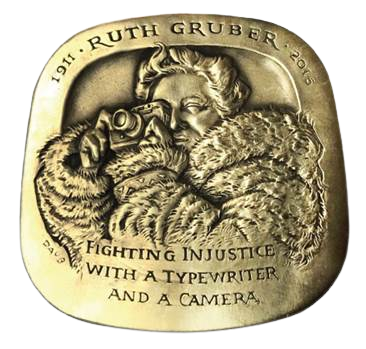 |  |
Medal struck by The Highland Mint in quantities of 88 bronze, 52 pure silver, and 30 gold-plated silver. Obverse (left) designed by Eugene Daub: Portrait with camera, RUTH GRUBER/1911-2016/FIGHTING INJUSTICE WITH A TYPEWRITER AND A CAMERA/DAUB. Reverse (right) designed by Mel Wacks: THE JEWISH-AMERICAN HALL OF FAME. 49 x 47 mm.
Ruth Gruber graduated from New York University at eighteen and two years later, she became the youngest PhD in the world. Gruber was appointed by U.S. Secretary of the Interior Harold L. Ickes in 1941 to report on conditions in the Alaska Territory. She captured pictures of the lives and customs of the native population. The iconic photo taken of Gruber in Alaska inspired the plaque/medal design by Eugene Daub.
Gruber continued her career as a journalist following the war, authoring 19 books and working for various U.S. publications as a correspondent in the Middle East and Europe. The movie Exodus (1960), starring Paul Newman, was based on Gruber’s 1948 book Destination Palestine: The Story of the Haganah Ship Exodus 1947.
When President Roosevelt decided to accept a thousand European immigrants in the midst of World War II and the Holocaust, Secretary of the Interior Harold Ickes chose Ruth Gruber to go on a secret mission to escort the refugees to the United States. Ickes made her a “simulated general” so in case the military aircraft she flew in was shot down and she was caught by the Nazis, she would be kept alive according to the Geneva Convention. The journey — which culminated in the arrival of 984 refugees in New York harbor on August 3, 1944 and their being given sanctuary on an old army base in Oswego, New York — became “the defining Jewish moment” of Gruber’s life.
In a touching moment in Haven, her book recounting the voyage, Gruber recalls a rabbi conducting a service as the boat passed the Statue of Liberty, and her pride in telling the Jewish refugees of the Holocaust that the poem within the pedestal was written by Emma Lazarus, an American Jew.
While Roosevelt planned to allow the refugees to reside in the United States only until the end of hostilities, when the end of the war came, Gruber lobbied the President and Congress — with the help of Catholic, Jewish and Protestant clergy — and convinced the officials to let the refugees stay.